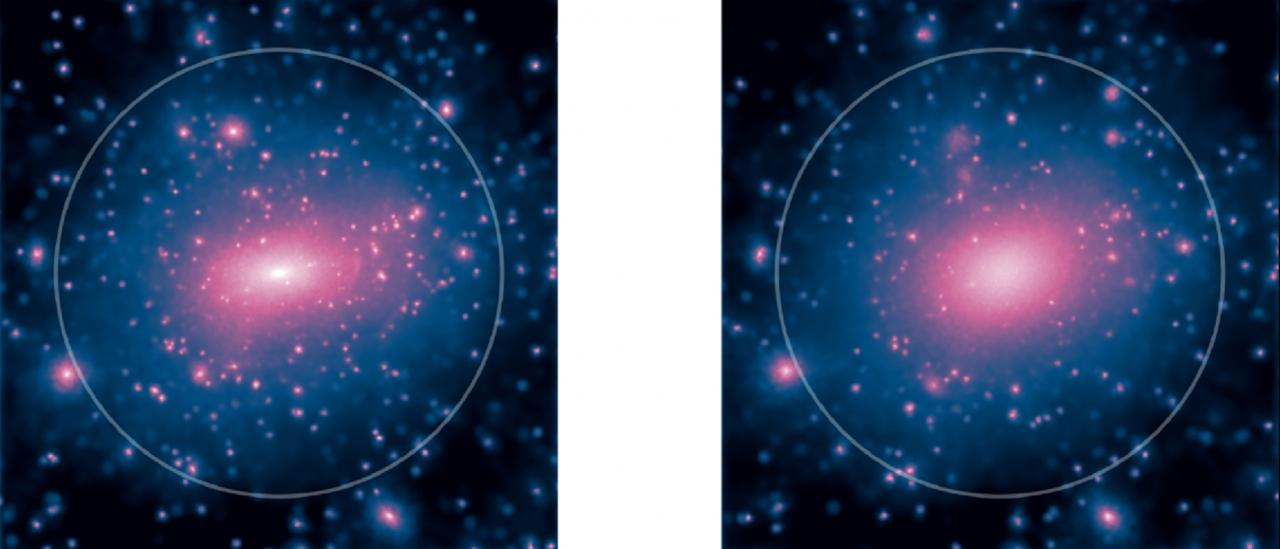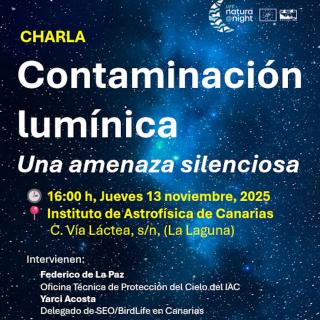The gravitational force in the Universe under which it has evolved from a state almost uniform at the Big Bang until now, when matter is concentrated in galaxies, stars and planets, is provided by what is termed ‘dark matter’. But in spite of the essential role that this extra material plays, we know almost nothing about its nature, behaviour and composition, which is one of the basic problems of modern physics. In a recent article in Astronomy & Astrophysics Letters, scientists at the Instituto de Astrofísica de Canarias (IAC)/University of La Laguna (ULL) and of the National University of the North-West of the Province of Buenos Aires (Junín, Argentina) have shown that the dark matter in galaxies follows a ‘maximum entropy’ distribution, which sheds light on its nature.
Dark matter makes up 85% of the matter of the Universe, but its existence shows up only on astronomical scales. That is to say, due to its weak interaction, the net effect can only be noticed when it is present in huge quantities. As it cools down only with difficulty, the structures it forms are generally much bigger than planets and stars. As the presence of dark matter shows up only on large scales the discovery of its nature probably has to be made by astrophysical studies.
MAXIMUM ENTROPY
To say that the distribution of dark matter is organized according to maximum entropy (which is equivalent to ‘maximum disorder’ or ‘thermodynamic equilibrium’) means that it is found in its most probable state. To reach this ‘maximum disorder’ the dark matter must have had to collide within itself, just as gas molecules do, so as to reach equilibrium in which its density, pressure, and temperature are related. However, we do not know how the dark matter has reached this type of equilibrium.
“Unlike the molecules in the air, for example, because gravitational action is weak, dark matter particles ought hardly to collide with one another, so that the mechanism by which they reach equilibrium is a mystery”, says Jorge Sánchez Almeida, an IAC researcher who is the first author of the article. “However if they did collide with one another this would give them a very special nature, which would partly solve the mystery of their origin”, he adds.
The maximum entropy of dark matter has been detected in dwarf galaxies, which have a higher ratio of dark matter to total matter than have more massive galaxies, so it is easier to see the effect in them. However, the researchers expect that it is general behaviour in all types of galaxies.
The study implies that the distribution of matter in thermodynamic equilibrium has a much lower central density that astronomers have assumed for many practical applications, such as in the correct interpretation of gravitational lenses, or when designing experiments to detect dark matter by its self-annihilation.
This central density is basic for the correct interpretation of the curvature of the light by gravitational lenses: if it is less dense the effect of the lens is less. To use a gravitational lens to measure the mass of a galaxy one needs a model, if this model is changed, the measurement changes.
The central density also is very important for the experiments which try to detect dark matter using its self-annihilation. Two dark matter particles could interact and disappear in a process which is highly improbable, but which would be characteristic of their nature. For two particles to interact they must collide. The probability of this collision depends on the density of the dark matter; the higher the concentration of dark matter, the higher is the probability that the particles will collide.
“For that reason, if the density changes so will the expected rate of production of the self-annihilations, and given that the experiments are designed on the prediction of a given rate, if this rate were very low the experiment is unlikely to yield a positive result”, says Sánchez Almeida.
Finally, thermodynamic equilibrium for dark matter could also explain the brightness profile of the galaxies. This brightness falls with distance from the centre of a galaxy in a specific way, whose physical origin is unknown, but for which the researchers are working to show that it is the result of an equilibrium with maximum entropy.
SIMULATION VERSUS OBSERVATION
The density of dark matter in the centres of galaxies has been a mystery for decades. There is a strong discrepancy between the predictions of the simulations (a high density) and that which is observed (a low value). Astronomers have put forward many types of mechanisms to resolve this major disagreement.
In this article, the researchers have shown, using basic physical principles, that the observations can be reproduced on the assumption that the dark matter is in equilibrium, i.e., that it has maximum entropy. The consequences of this result could be very important because they indicate that the dark matter has interchanged energy with itself and/or with the remaining “normal” (baryonic) matter.
“The fact that equilibrium has been reached in such a short time, compared with the age of the Universe, could be the result of a type of interaction between dark matter and normal matter in addition to gravity”, suggests Ignacio Trujillo, an IAC researcher and a co-author of this article. “The exact nature of this mechanism needs to be explored, but the consequences could be fascinating to understand just what is this component which dominates the total amount of matter in the Universe”.
Article: Jorge Sánchez Almeida, Ignacio Trujillo and Ángel Ricardo Plastino. “The principle of maximum entropy explains the cores observed in the mass distribution of dwarf galaxies”. 2020, A&A Letters. DOI: https://doi.org/10.1051/0004-6361/202039190
- A&A: https://www.aanda.org/articles/aa/pdf/2020/10/aa39190-20.pdf
- Arxiv: https://arxiv.org/abs/2009.08994
Contact at the IAC:
- Jorge Sánchez Almeida: jos [at] iac.es (jos[at]iac[dot]es)
- Ignacio Trujillo: itc [at] iac.es (itc[at]iac[dot]es)



